Disclosure: Meeple Mountain received a free copy of this product in exchange for an honest, unbiased review. This review is not intended to be an endorsement.
Here’s a fun fact for you: did you know that potato chips were served to a customer in a sealed package for the first time in 1926? It took humankind 73 years from the potato chip’s inception (1853) to put the potato chip into a bag. Hard to believe, but it’s true.
The concept was designed by a woman named Laura Scudder. She and her workers used hot irons to melt wax paper to form pouches, fill them with chips, and then iron them shut. To say that they sold like hotcakes a) implies that anyone still calls them ‘hotcakes’ and b) vastly understates just how prevalent the potato chip bag has become in our society and culture. It’s hard to envision a world without this tasty delicacy and its instantly recognizable packaging.
Perhaps that familiarity is what inspired the look and feel of Bag of Chips, one of Blue Orange Games’s recent titles. Co-designed by Mathieu Aubert (a relatively unknown designer with only one other game, Shadows: Amsterdam under his belt) and Théo Rivière (Draftosaurus, Naga Raja, The Loop), the game is contained within a package that closely resembles a bag of potato chips. Inside of the small package are a number of Potato Chip tokens, four Board cards, a deck of Objective cards, some Rewards tokens, and the rules pamphlet.
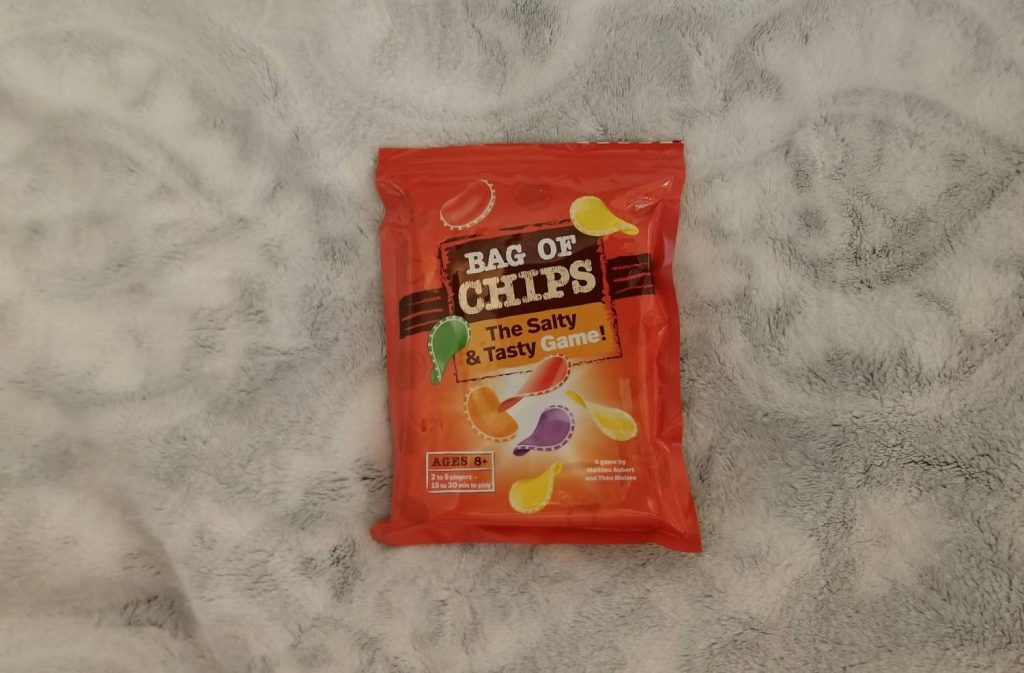
Over the course of a round of Bag of Chips: the players will be given Objective cards, Potato Chips will be drawn from the bag and placed onto the Board cards, and players will be tasked with choosing a few Objective cards to discard and a few to keep and possibly score. Some will score you positive points, but some may wind up costing you. The player with the highest total at the end of the round wins and collects a number of Reward tokens. The game is played over a series of rounds until one of the players has collected a prescribed number of tokens.
Of course, that’s a high-level overview. If you’ve heard enough and just want to know what I think, feel free to skip ahead to the Thoughts section. Otherwise, read on as we learn to play Bag of Chips.
Opening the Bag
A game of Bag of Chips is set up like this:
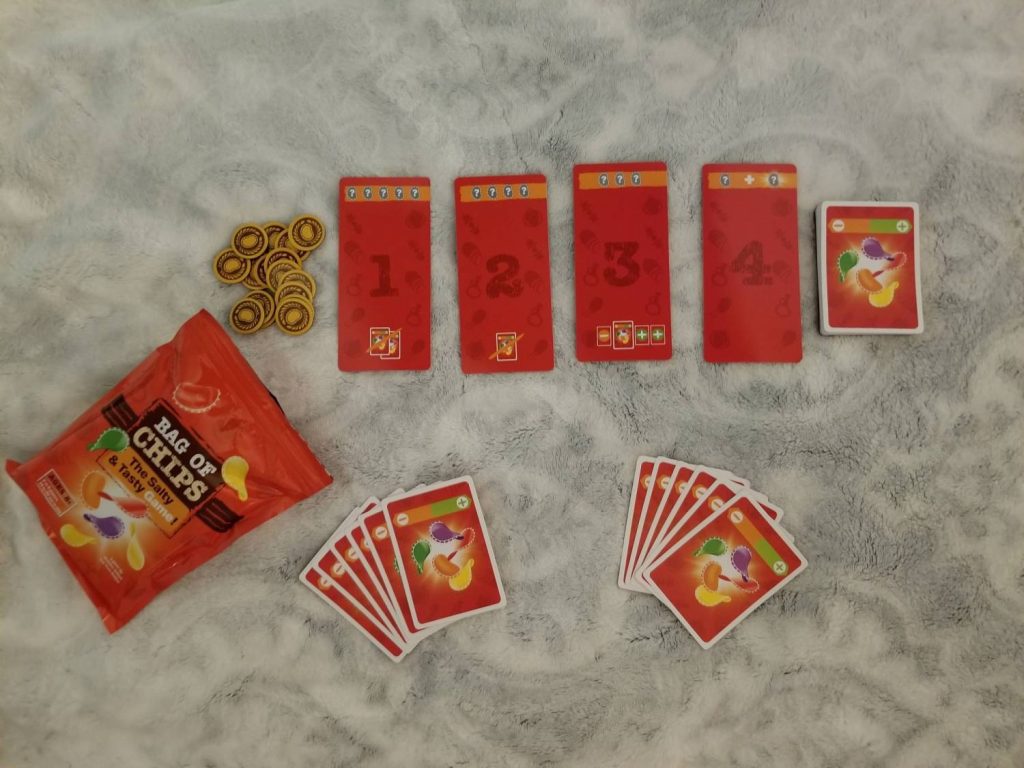
The four Board cards are laid side-by-side in numeric order. The Objective card deck is shuffled and each player is dealt six cards at random. The remainder of the deck is set close by along with the Reward tokens and the Recap card (which shows the frequency breakdown of each chip color in the game). Then all the Potato Chip tokens are added to the bag and a start player is chosen. Now you’re ready to play.
Digging In
A round of Bag of Chips is pretty easy. The start player draws five Potato Chip tiles from the bag and places them onto the first Board card. Based on which chips have come out, the players look over the Objective cards in their hand and choose two to discard into a face-down discard pile in front of them. Four chips are drawn for the second Board card and only one Objective is chosen. Three chips are drawn for the third card and this is where it gets a little tricky.
At this point, each player will have three Objective cards in hand. One of these must be placed face up to the left of the discard pile. This is the negative side (this will make sense later). The other two are placed to the right of the discards. This is the positive side.
For the fourth Board card, two chips are drawn, one at a time (some Objective cards reference the very last chip drawn during the round, so the timing is important here). Then the players assess their face up Objective cards to see how well they’ve done. If a card on the right scores, it adds value to the player’s end total. If the card on the left scores, it detracts from that total. If a card doesn’t score, it has no bearing on anything. The player with the highest total wins the round and collects a number of Reward tokens. The winner of the game is the first to collect a certain number of these.
A Stroll Down the Chip Aisle
There are five types of chips in the game: potato (yellow), onion (green), vinegar (purple), barbecue (red), and chicken (orange). Each Objective card references these in some way.
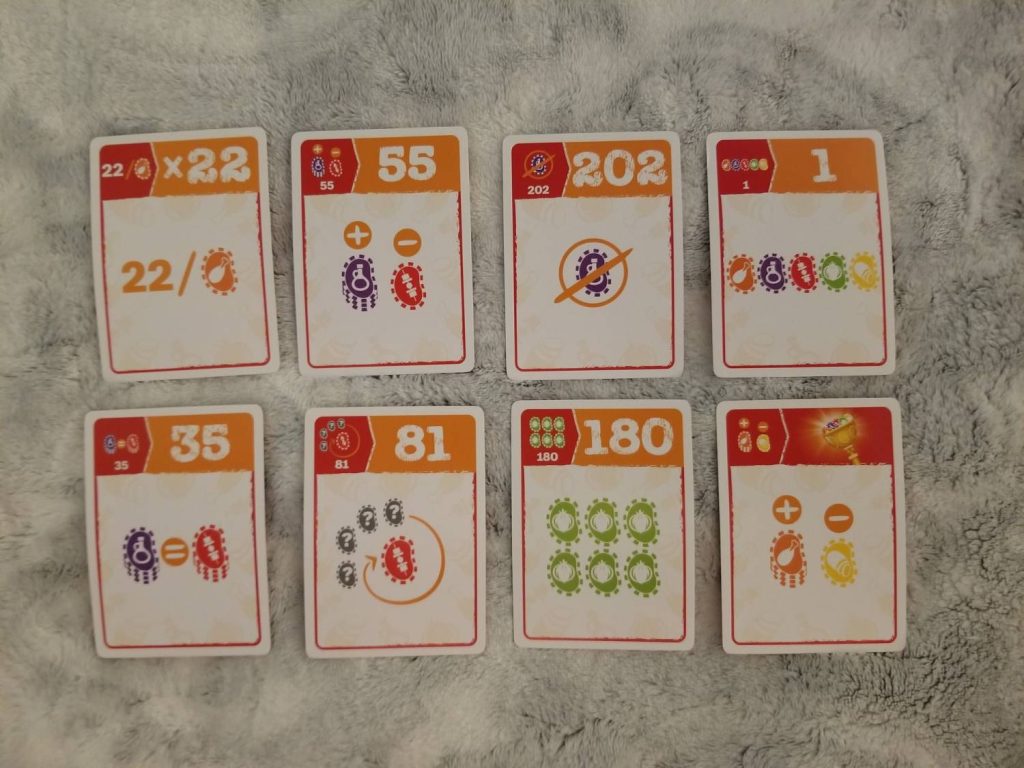
All in all, there are eight different Objective types. I’m not going to go into all of them here, but here are a few examples.
Some reward for having specific combinations of chip types in play. Some reward if a specific type of chip is the last chip drawn in the round. Others reward having more of one type of chip than another. And some reward more points the more chips of a certain type are in the display.
Thoughts
A few months ago, Blue Orange Games approached Meeple Mountain about reviewing some of their newer titles. Intrigued by what was on offer, I eagerly put my name in the hat and began the long wait. Thus it was that last week I was pleasantly surprised when I opened the package I’d been waiting for and found not one, but two games waiting for me inside of the box. One of them, Museum Suspects, was expected and the other was Bag of Chips, a most unexpected surprise.
“Huh,” I thought. “Did I ask for this one? Surely I’d remember if I’d asked to review a game that looked like a bag of potato chips. That’s something one remembers, right?”
Normally I’d never even give a game like this a second glance. I am not one for party games, you see. But back in 2017, my wife had persuaded me to try out Cobra Paw, another silly party game, and I wound up liking that one more than I’d expected I would. So, I decided to go ahead and give this game a go. Who knows? Maybe it would strike that same chord that Cobra Paw did. Maybe this game would turn me into a full-fledged, over-the-top, party game junkie.
Spoilers: It did not.
Bag of Chips is simultaneously like many games I’ve played before and also nothing like them. I suspect it has a lot to do with the packaging. I can honestly say that I have never seen a game that closely resembles a bag of potato chips. I have, however, played plenty of push-your-luck games and plenty of betting games, many far better than this one and many far worse. Bag of Chips falls somewhere in the middle. It’s neither the best game I have ever played, nor is it the worst. It’s just okay. And that’s okay.
Bag of Chips isn’t setting out to reinvent the wheel. It just sets out to turn it slightly so that you have to look at it a different way. And, in that regard, it’s pretty successful.
Bag of Chips occupies an interesting headspace. It’s a betting game where you don’t feel like you’re betting. Typically, a betting game would have you adding something to a growing pool of somethings with the winner taking the spoils. Instead, Bag of Chips has you placing your bets by taking things away. You’re saying, “based on the limited information available to me, I wager that I can fulfill at least two of these cards that I’m hanging onto”. But it goes beyond that. You’re also betting on which cards you won’t be able to score. You want to have one of these losers on hand when it comes to the end of the round because if you don’t then, whoa buddy, it’s going to hurt.
It took me a few rounds to really grasp the game’s insidious nature. I want to score and I want to score big. But I also want to fail, but not completely. I want to fail like Goldilocks, just right, and I want to be worse at failing than my opponents. Because if I fail better than they do, then they’ll win the round. So, I guess in a way, Bag of Chips also has a bit of trick taking built into it.
Like I said, interesting headspace.
I do have a couple of quibbles that do not make for satisfactory experiences, however. For instance, the iconography on the Objective cards will have you constantly going back to the rules pamphlet to try and suss out their meanings. For example, consider the “x times the number of <type of potato chip>” Objectives.
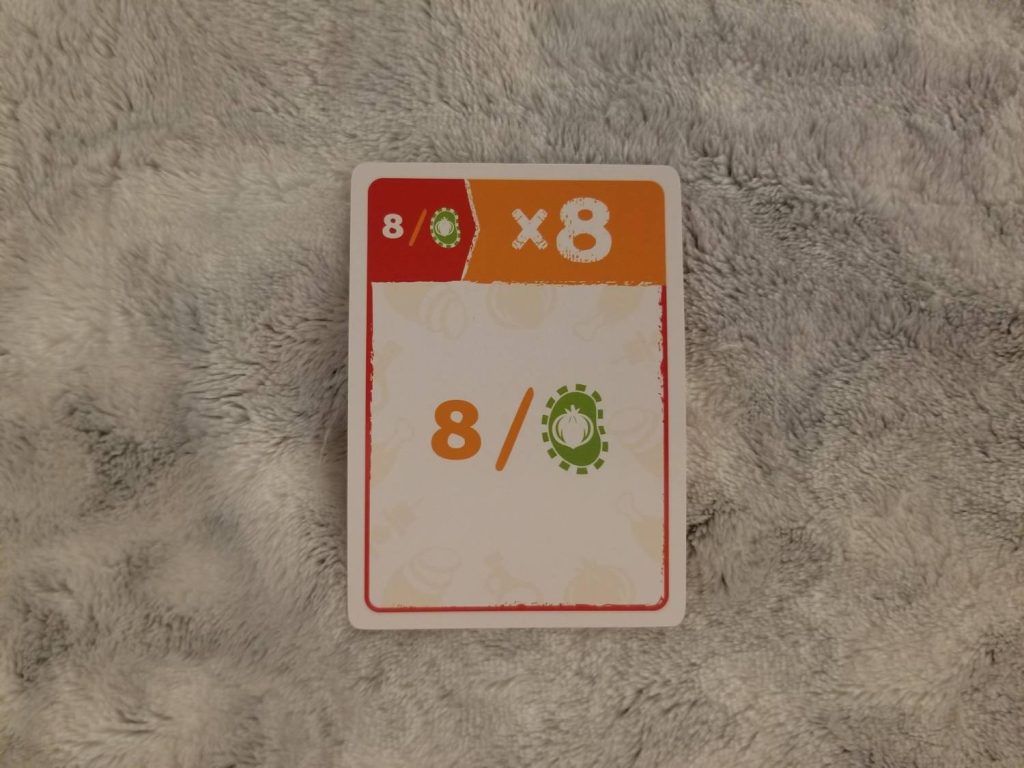
The iconography at the top left and in the middle of the card looks like a division equation. At the top right is shown a multiplier. What is this card doing? Am I dividing the number by the number of matching potato chips? What is that multiplier for? The / should be a *. It’s not a huge impediment, but little things like this crop up pretty frequently in your first few games.
Another slight impediment is the bag itself. You’re expected to draw chips from the bag over the course of the round, but the material the bag is made of is pretty rigid and there’s not a lot of room to get your fingers in there. In most games I have played, you have to resort to dumping the chips out, counting out what you need, and shoving the remainders back in there. If the bag were larger or if the opening were slightly wider, we wouldn’t be having this conversation, but here we are. It’s a classic case of clever packaging getting in the way of gameplay.
Do I love the game? I do not. Do I like it? I like it well enough. I could see myself pulling this out if I’m just looking for something lighter to play. I could even see myself taking this with me to a restaurant to play while I wait for my food to arrive. But, I could never see myself recommending Bag of Chips as the star attraction. It will always be just a snack among much meatier fare.
And maybe that’s where Bag of Chips is meant to belong. A delightful snack and nothing else.


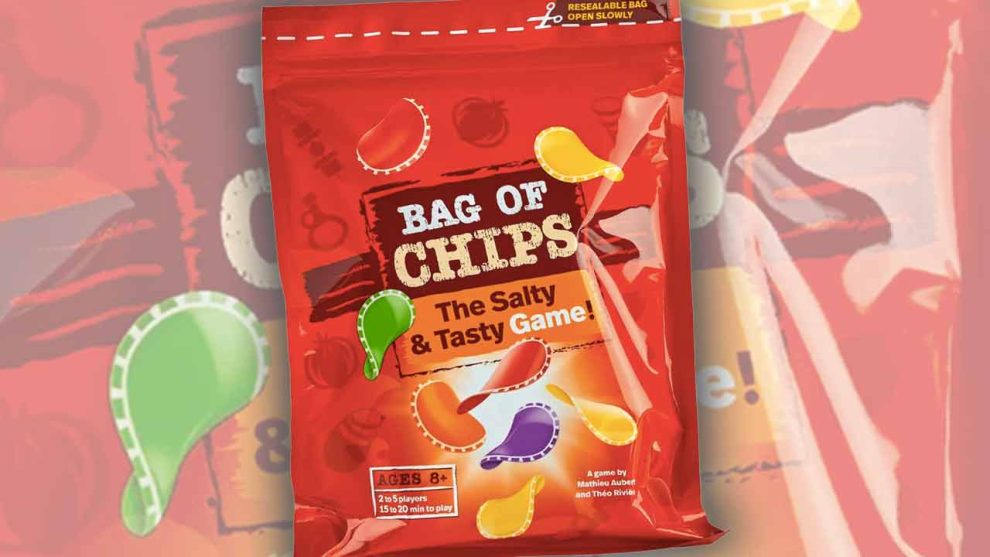









Add Comment